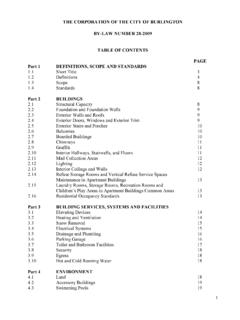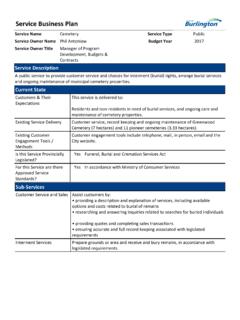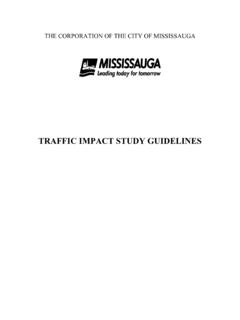Transcription of Transportation Impact Study (TIS) Guidelines (Final)
1 Transportation Impact Study Guidelines Dated: January 2015 Transportation Impact Study Guidelines TABLE OF CONTENTS Transportation Impact .. 2 Need and Justification .. 2 Purpose of Guidelines .. 2 Transportation Demand General Transportation Impact Study Requirements .. 3 Need for Transportation Impact Study .. 3 Staff Consultation .. 4 Study Updates .. 4 Transportation Impact Study Outline .. 4 Description of the Development Proposal and the Study Area.. 4 Description of the Development or Redevelopment Proposal .. 4 Study Area.
2 5 Horizon Year and Time Periods for Analysis .. 6 Horizon Year.. 6 Peak Periods .. 6 Existing Traffic Conditions .. 6 Background Traffic Growth .. 6 Background Traffic .. 6 Other Area Developments .. 7 Transportation Network Improvements .. 7 Transit Considerations .. 7 Estimation of Travel Demand.. 7 Trip Generation.. 7 Trip Distribution.
3 8 Trip Assignments .. 8 Summary of Traffic Demand Estimates.. 8 Evaluation of Impacts of Site Generated Traffic .. 9 Capacity Analysis at Intersections.. 9 Safety Analysis .. 10 Traffic Collision Sight Access and Sight Distance Evaluation .. 11 Transportation System Mitigation .. 12 Required Roadway .. 12 Required Traffic Signal .. 12 Preliminary Cost Estimate .. 12 Recommendations .. 12 Documentation and .. 13 Transportation Impact Study Guidelines 2 INTRODUCTION Transportation Impact Study The goal of a Transportation Impact Study (TIS) is to assess the potential effects of traffic caused by a proposed development on Regional and local roadways and to identify the required roadway and access improvements needed to ensure that the roadway system will operate at an acceptable level upon completion of the proposed development.
4 Transportation Impact Studies are an important part of the development review and approval process to assist developers and public agencies in making land use decisions, such as Official Plan amendments, re-zonings, subdivisions, site plans, planning approvals and other development reviews, where the proposal may have a significant Impact on traffic and Transportation operations. Transportation Impact Studies benefit the municipality by: Providing decision makers with a basis on which to assess Transportation implications of proposed development applications; Providing a rational basis on which to evaluate if the scale of development is appropriate for a particular site and what improvements may be necessary, on and off the site, to provide safe and efficient access and traffic flow; Providing a basis for assessing existing or future localized Transportation system deficiencies that should be improved; Addressing Transportation -related issues associated with development proposals that may be of concern to neighbouring residents, businesses and property owners.
5 And A Transportation Impact Study may vary in scope and complexity depending on the type and size of the proposed development. Need and Justification Halton Region has prepared these Guidelines in order to streamline the approval process and provide a standardized framework for consultants to follow when submitting traffic/ Transportation studies for review and should be complemented with appropriate Transportation engineering judgement. Purpose of Guidelines The purpose of these Guidelines is to ensure that Transportation Impact Studies prepared for the Region s review meet the following criteria: Objective assessment the Study will evaluate the impacts of proposed new development in a rational manner; Consistency the Study will utilize assumptions consistent with the Region s accepted methodologies and parameters and thus be comparable to other Transportation studies in the Region; Transportation Impact Study Guidelines 3 Recognized by developers and consultants the Guidelines will provide a standard approach to be followed and will reduce confusion and delay in processing development proposals.
6 Promote understanding of process the steps outlined in these Guidelines will enable proponents, reviewers and elected officials to understand the process more effectively; and Ease of review by staff a standardized set of Guidelines will aid the efficiency of staff in reviewing Transportation Impact Studies. Transportation Demand Management Transportation Demand Management (TDM) is a term used to describe a wide variety of initiatives aimed at reducing the amount of travel by single occupant vehicles and achieving a more balanced mode split in the Transportation system, particularly during the commuter peak hours. The Region launched the Smart Commute Initiative in 2006 which is a program of Metrolinx and the municipalities in the GTHA. Smart Commute Halton encourages active and sustainable Transportation by offering services and tools designed to make commuting easier for the employees of local organizations.
7 Smart Commute is continuing to expand across the Region in partnership with Metrolinx, the local municipalities and local employers. Traffic Impact Studies should consider TDM initiatives such as: -Promotion and support for reduced single occupant vehicle use through carpool programs, -Promotion of transit and employer subsidized transit programs, -Implementation of bicycle/pedestrian infrastructure and bikeshare programs, -Multi-modal marketing programs (web site, access guides, individualized marketing programs, information kiosks, way-finding signage, emergency ride home), -Parking Programs ( Transportation allowance, preferential parking, unbundled parking), -Alternative Work Programs (compressed work weeks, flexible work schedules, telework programs) GENERAL Transportation Impact Study REQUIREMENTS Staff Consultation It is imperative that prior to commencing a Transportation Impact Study , the consultant meet with Regional and area municipal staff, as appropriate, in order to review the level of detail and confirm the Scope of Work for the TIS, arrange contacts with the various affected road jurisdictions and to determine data requirements and its availability.
8 In addition to Halton Region requirements, the area municipal and provincial roadway authorities may require additional information or analysis to satisfy their requirements for a development/redevelopment proposal. The proponent should contact these roadway authorities, where applicable, to determine these requirements. Transportation Impact Study Guidelines 4 Study Updates Generally, a Transportation Impact Study will have a shelf life of five years. Major changes within the Study area may reduce the life of the document if they were not considered in the Impact assessment. Where the timing of subsequent development approvals exceeds five years, a new Study will generally be required. Data Collection The applicant must provide both electronic and hard copies of all raw data collected for the TIS.
9 This includes but is not limited to the following: Turning Movement Counts; Traffic signal timings; ATR & AADT counts; Collision records; Gap Study observations; Queue Studies; Proxy site surveys; Cordon counts; Transit information Pedestrian and Cyclist circulation plan; Other data as requested Transportation Impact Study Outline The following sections outline the format and requirements of the Transportation Impact Study . Area municipal or provincial roadway authorities may require additional information or analyses beyond the Regional requirements outlined in these Guidelines . The contents and extent of the TIS generally depend on the location and size of the proposed development/redevelopment and the conditions prevailing in the surrounding area. Description of the Proposal and the Study Area.
10 A description of the development proposal, its location and the proposed Transportation Impact Study area is required to permit Regional Staff to identify the site location, its anticipated operation and area of potential Impact . In addition, this information allows timely review of key Study assumptions ranging from the Study area limits and horizon years to the trip assignment assumptions. Description of the Development or Redevelopment Proposal The Transportation Impact Study should provide a full description of the proposed development. This may include the following elements, as applicable: Municipal address; Existing land uses or permitted use provisions in an Official Plan, Official Plan Amendments, Zoning By-law etc. Proposed land uses and relevant planning regulations to be used in the Study ; Transportation Impact Study Guidelines 5 Total building size and building locations; Floor space including a summary of each type of use/number of residential units; Anticipated date of occupancy; Approximate hours of operations; Planned phasing of the development; Near-by intersections and accesses to adjacent developments and those on the opposite side of the road including type of control; Proposed access points and type of access (full movement, right-in-right-out, turning movement restrictions, etc.)













